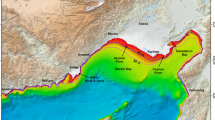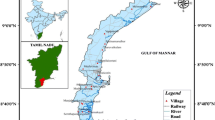Abstract
This paper presents a new method for coastal vulnerability assessment (CVA), which relies upon three indicators: run-up distance (as a measurement of coastal inundation), beach retreat (as a measurement of potential erosion), and beach erosion rate (obtained through the shoreline positions in different periods). The coastal vulnerability analysis of Sele Coastal Plain to storm impacts is examined along a number of beach profiles realized between 2008 and 2009. This particular study area has been selected due to its low-lying topography and high erosion propensity. Results are given in terms of an impact index, performed by combining the response due to coastal inundation, storm erosion, and beach erosion rate. This analysis is implemented on the basis of morphosedimentary characteristics of the beach, wave climate evaluation, and examination of multitemporal aerial photographs and topographic maps. The analysis of the final results evidences different coastal responses as a function of the beach width and slope, which in turn depend on the local anthropization level. The comparison of this method with a Coastal Vulnerability Index method evidences the better attitude of CVA index to take into account the different beach features to explain the experienced damages in specific stretches of the coastline considered.












Similar content being viewed by others
References
Alberico I, Amato V, Aucelli PPC, D’Argenio B, Di Paola G, Pappone G (2012a) Historical shoreline evolution and recent shoreline trends of Sele Plain coastline (Southern Italy). The 1870–2009 time window. J Coast Res 28:1638–1647. doi:10.2112/JCOASTRES-D-10-00197.1
Alberico I, Amato V, Aucelli PPC, Di Paola G, Pappone G, Rosskopf CM (2012b) Historical and recent changes of the Sele River coastal plain (Southern Italy): natural variations and human pressures. Rend Lincei 23:3–12. doi:10.1007/s12210-011-0156-y
Alexandrakis G, Poulos S, Petrakis S, Collins M (2011) The development of a Beach Vulnerability Index (BVI) for the assessment of erosion in the case of the North Cretan Coast (Aegean Sea). Hell J Geosci 45:11–21
Amato V, Aucelli PPC, Ciampo G, Cinque A, Di Donato V, Pappone G, Petrosino P, Romano P, Rosskopf CM, Russo Ermolli E (2013) Relative sea level changes and paleogeographical evolution of the southern Sele plain (Italy) during the Holocene. Quatern Int 288:112–128. doi:10.1016/j.quaint.2012.02.003
Arun Kumar A, Kunte PD (2012) Coastal vulnerability assessment for Chennai, east coast of India using geospatial techniques. Nat Hazards 64:853–872. doi:10.1007/s11069-012-0276-4
Aucelli PPC, Amato V, Budillon F, Senatore MR, Amodio S, D’Amico C, Da Prato S, Ferraro L, Pappone G, Russo Ermolli E (2012) Evolution of the Sele River coastal plain (southern Italy) during the late quaternary by inland and offshore stratigraphical analyses. Rend Lincei 23:81–102. doi:10.1007/s12210-012-0165-5
Bartole R, Savelli D, Tramontana M, Wezel FC (1984) Structural and sedimentary features in the Tyrrhenian margin off Campania, Southern Italy. Mar Geol 55:163–180
Benassai G (2006) Introduction to coastal dynamics and shoreline protection. Wit Press, Southampton
Benassai G, Ascione I, (2006) Implementation and validation of wave watch III model offshore the coastlines of Southern Italy. OMAE 2006 92555:1–8
Benassai G, Chirico F, Corsini S (2009) Una metodologia per la definizione del rischio da inondazione costiera. Studi Costieri 16:51–72
Benassai G, Di Paola G, Aucelli PPC, Maffucci A (2012) The response of Sele coastal plain to storm impacts. Rend Online Soc Geol Italy 21:474–476
Benassai G, Montuori A, Migliaccio M, Nunziata F (2013) Sea wave modeling with X-band COSMO-SkyMed© SAR-derived wind field forcing. Ocean Sci 9:325–341. doi:10.5194/os-9-325-2013
Booij N, Ris RC, Holthuijsen LH (1999) A third-generation wave model for coastal regions 1: model description and validation. J Geophys Res 104:7649–7666. doi:10.1029/98JC02622
Bosom E, Jiménez JA (2011) Probabilistic coastal vulnerability assessment to storms at regional scale—application to Catalan beaches (NW Mediterranean). Nat Hazards Earth Syst Sci 11:475–484
Bruun P (1962) Sea-level rise as a cause of shore erosion. J Waterw Harbours Div 88(1–3):117–130
Carter TR, Parry ML, Nishioka S, Harasawa H (1994) Technical guidelines for assessing climate change impacts and adaptation. University College London, London, and Centre for Global Environmental Research, Tskuba, J
Casciello E, Cesarano M, Pappone G (2006) Extensional detachment faulting on the Tyrrhenian margin of the southern Apennines contractional belt (Italy). J Geol Soc 163:617–629
Cooper NJ, Jay H (2002) Predictions of large-scale coastal tendency: development and application of a qualitative behavior-based methodology. J Coast Res SI36:173–181
Cutter SL (1996) Vulnerability to environmental hazards. Prog Hum Geogr 20(4):529–539
Di Paola G (2011) Geological and geo-morphological characterization of coastal Sele Plain (Campania, Italy) and considerations about its vulnerability. PhD Thesis, Università degli Studi del Molise, Italy. http://hdl.handle.net/2192/141
Di Paola G, Iglesias J, Rodríguez G, Benassai G, Aucelli PPC, Pappone G (2011) Estimating coastal vulnerability in a meso-tidal beach by means of quantitative and semi-quantitative methodologies. J Coast Res SI61:303–308. doi:10.2112/SI61-001.30
Diez PG, Perillo GME, Piccolo C (2007) Vulnerability to sea-level rise on the coast of the Buenos Aires Province. J Coast Res 23(1):119–126
Directorate General Environment European Commission (2004) Living with coastal erosion in Europe: sediment and space for sustainability. Part I: major findings and policy recommendations of the EUROSION project
Gaki-Papanastassiou K, Karymbalis E, Poulos SE, Seni A, Zouva C (2010) Coastal vulnerability assessment to sea-level rise based on geomorphological and oceanographical parameters: the case of Argolikos Gulf, Peloponnese, Greece. Hell J Geosci 45:109–122
Gornitz VM, Daniels RC, White TW, Birdwell KR (1994) The development of a coastal risk assessment database: vulnerability to sea-level rise in the U.S. Southeast. J Coast Res SI12:327–338
Gornitz VM, Beaty TW, Daniels RC (1997) A coastal hazards data base for the U.S. West Coast. ORNL/CDIAC-81, NDP-043C, Oak ridge national laboratory, Oak ridge, Tennessee, USA
Hallermaier RJ (1977) Use for a calculated limit depth to beach erosion. In: Proceedings of the XVI coastal engineering conference, pp 1493–1512
Hasselmann K, Barnett TP, Bouws E, Carlson H, Cartwright DE, Enke K, Ewing JA, Gienapp H, Hasselmann DE, Kruseman P, Meerburg A, Mller P, Olbers DJ, Richter K, Sell W, Walden H (1973) Measurements of wind-wave growth and swell decay during the Joint North Sea Wave Project (JONSWAP). Deutsches Hydrographisches Institute, Hamburg, D
Holthuijsen LH, Booij N, Ris RC (1993) A spectral wave model for the coastal zone. In: Proceedings of the 2nd international symposium on ocean wave measurement and analysis, pp 630–641
IIM (2002) Tidal data base, Istituto Idrografico della Marina, Genova, I
IPCC (2007) Fourth assessment report—climate change 2007. Intergovernmental panel on climate change. Cambridge University Press, Cambridge
Jiménez JA, Ciavola P, Balouin Y, Armaroli C, Bosom E, Gervais M (2009) Geomorphic coastal vulnerability to storms in microtidal fetch-limited environments: application to NW Mediterranean and N Adriatic Seas. J Coastal Res SI56:1641–1645
Krause G, Soares C (2004) Analysis of beach morphodynamics on the Bragantinian mangrove peninsula (Pará, North Brazil) as prerequisite for coastal zone management recommendations. Geomorphology 60:225–239. doi:10.1016/j.geomorph.2003.08.006
Kriebel DL, Dean RG (1993) Convolution method for time-dependent beach-profile response. J Waterw Port Coast Ocean Eng 119(2):204–207
Lozano I, Devoy RJN, May W, Andersen U (2004) Storminess and vulnerability along the Atlantic coastlines of Europe: analysis of storm records and of a greenhouse gases induced climate scenario. Mar Geol 210:205–225
Masselink G, Short AD (1993) The effect of tidal range on beach morphodynamics and morphology: a conceptual beach model. J Coast Res 9:785–800
Medatlas Group (2004) Wind and wave atlas of the Mediterranean Sea, pp 419
Mendoza ET, Jiménez JA (2008) Storm induced beach erosion potential on the Catalonian coast. J Coast Res 48:81–88
Michalakes J, Dudhia J, Gill D, Henderson T, Klemp J, Skamarock W, Wang W (2005) The weather research and forecasting model: software architecture and performance. In: Zwiefhofer W, Mozdzynski G (eds) Proceedings of the eleventh ECMWF workshop on the use of high performance computing in meteorology. World Scientific, pp 156–168
Nicholls RJ, de la Vega-Leinert AC (2000) Synthesis and upscaling of sea-level rise vulnerability assessment studies (SURVAS): SURVAS methodology. Flood Hazard Research Centre, Middlesex University, USA
Özyurt G, Ergin A (2010) Improving coastal vulnerability assessments to sea-level rise: a new indicator based methodology for decision makers. J Coast Res 26(2):265–273
Pappone G, Alberico I, Amato V, Aucelli PPC, Di Paola G (2011) Recent evolution and the present-day conditions of the Campanian Coastal plains (South Italy): the case history of the Sele River Coastal plain. WIT Trans Ecol Environ 149:15–27. doi:10.2495/CP110021
Pappone G, Aucelli PPC, Alberico I, Amato V, Antonioli F, Cesarano M, Di Paola G, Pelosi N (2012) Relative sea-level rise and marine erosion and inundation in the Sele River coastal plain (Southern Italy): scenarios for the next century. Rend Lincei 23:121–129. doi:10.1007/s12210-012-0166-4
Piscopia R, Inghilesi R, Panizzo A, Corsini S, Franco L (2002) Analysis of 12-year wave measurements by the Italian Wave Network. In: Proceedings of the 28th ICCE conference, Cardiff, pp 121–133
Rahmstorf S (2007) A semi-empirical approach to projecting future sea-level rise. Science 315:368–370
RON (2012) Rete ondametrica nazionale. http://www.idromare.it/analisi_dati.php. Accessed 17 May 2012
Short AD (1999) Beach and Shoreface morphodynamics. Wiley, Chichester
Smith AWS, Jackson LA (1992) The variability in width of the visible beach. Shore Beach 60(2):7–14
Stockdon HF, Holman RA, Howd PA, Sallenger AH (2006) Empirical parameterization of setup, swash, and run-up. Coast Eng 53(7):573–588
Thieler ER, Hammar-Klose ES (1999) National assessment of coastal vulnerability to sea-level rise, U.S. Atlantic Coast. U.S. Geological Survey, Open-File Report, pp 99–593
Thieler ER, Himmelstoss EA, Zichichi JL, Miller TL (2005) Digital shoreline analysis system (DSAS) version 3.0: an ArcGIS© extension for calculating shoreline change. U.S. Geological Survey Open File Report 1304
van Rijn LC, Walstra DJR, Grasmeijer B, Sutherland J, Pan S, Sierra JP (2003) The predictability of cross-shore bed evolution of sandy beaches at the time scale of storms and seasons using process-based Profile models. Coast Eng 47:295–327
Whitam GB (1974) Linear and nonlinear waves. Wiley, New York
Acknowledgments
The authors wish to thank G. Mastronuzzi and the anonymous reviewer, whose suggestions greatly improved the manuscript.
Author information
Authors and Affiliations
Corresponding author
Rights and permissions
About this article
Cite this article
Di Paola, G., Aucelli, P.P.C., Benassai, G. et al. Coastal vulnerability to wave storms of Sele littoral plain (southern Italy). Nat Hazards 71, 1795–1819 (2014). https://doi.org/10.1007/s11069-013-0980-8
Received:
Accepted:
Published:
Issue Date:
DOI: https://doi.org/10.1007/s11069-013-0980-8




